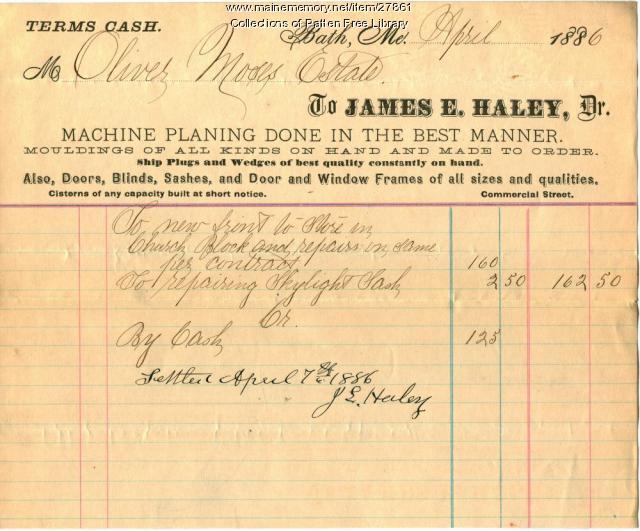Keywords: Commercial Architecture
Item 104309
"Strathglass Building," Rumford Falls, 1912
Contributed by: Maine Historical Society Date: circa 1910 Location: Rumford Media: Postcard
Item 27861
Haley bill for Church Block, Bath, 1886
Contributed by: Patten Free Library Date: 1886-04-07 Location: Bath Media: Ink on paper
Item 116434
Hannaford Brothers Warehouse, Portland, 1919-1920
Contributed by: Maine Historical Society Date: 1919–1920 Location: Portland Client: Hannaford Brothers Company Architect: John Calvin Stevens and John Howard Stevens Architects
Item 109538
Commercial Block for G.M. Coombs, Auburn, 1891
Contributed by: Maine Historical Society Date: 1891 Location: Auburn Client: George M. Coombs Architect: George M. Coombs
Exhibit
The Life and Legacy of the George Tate Family
Captain George Tate, mast agent for the King of England from 1751 to the Revolutionary War, and his descendants helped shape the development of Portland (first known as Falmouth) through activities such as commerce, shipping, and real estate.
Exhibit
A Snapshot of Portland, 1924: The Taxman Cometh
In 1924, with Portland was on the verge of profound changes, the Tax Assessors Office undertook a project to document every building in the city -- with photographs and detailed information that provide a unique view into Portland's architecture, neighborhoods, industries, and businesses.
Site Page
Architecture & Landscape database - John Calvin Stevens
"… 1889 book “Examples of American Domestic Architecture.” John Calvin Stevens is one of the best documented figures in Maine architectural history…"
Site Page
Architecture & Landscape database - Eaton W. Tarbell
"… included homes, schools, churches, and public, commercial, and industrial buildings. Much of the firm’s work was concentrated in the Bangor area as…"
Story
History of Forest Gardens
by Gary Libby
This is a history of one of Portland's oldest local bars
Lesson Plan
Longfellow Studies: "The Jewish Cemetery at Newport"
Grade Level: 6-8, 9-12
Content Area: English Language Arts, Social Studies
Longfellow's poem "The Jewish Cemetery at Newport" opens up the issue of the earliest history of the Jews in America, and the significant roles they played as businessmen and later benefactors to the greater community. The history of the building itself is notable in terms of early American architecture, its having been designed, apparently gratis, by the most noted architect of the day. Furthermore, the poem traces the history of Newport as kind of a microcosm of New England commercial cities before the industrialization boom. For almost any age student the poem could be used to open up interest in local cemeteries, which are almost always a wealth of curiousities and history. Longfellow and his friends enjoyed exploring cemeteries, and today our little local cemeteries can be used to teach little local histories and parts of the big picture as well.
Henry Wadsworth Longfellow visited the Jewish cemetery in Newport, RI on July 9, 1852. His popular poem about the site, published two years later, was certainly a sympathetic portrayal of the place and its people. In addition to Victorian romantic musings about the "Hebrews in their graves," Longfellow includes in this poem references to the historic persecution of the Jews, as well as very specific references to their religious practices.
Since the cemetery and the nearby synagogue were restored and protected with an infusion of funding just a couple years after Longfellow's visit, and later a congregation again assembled, his gloomy predictions about the place proved false (never mind the conclusion of the poem, "And the dead nations never rise again!"). Nevertheless, it is a fascinating poem, and an interesting window into the history of the nation's oldest extant synagogue.














